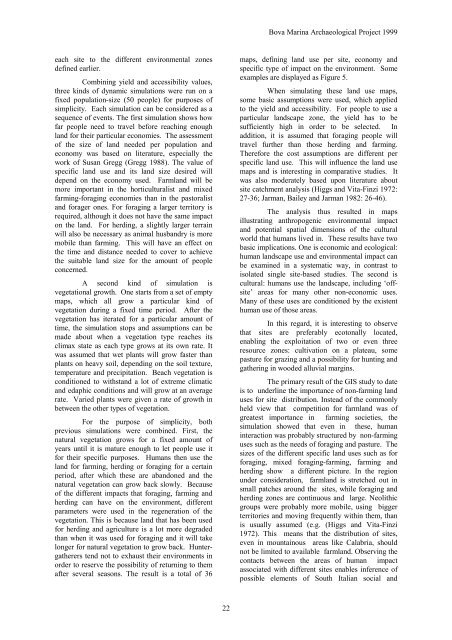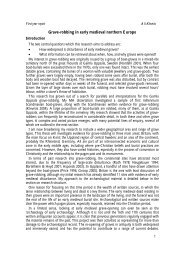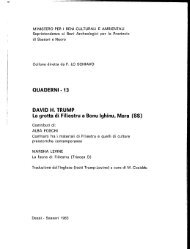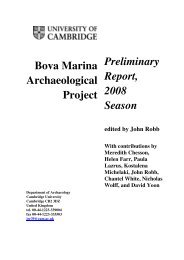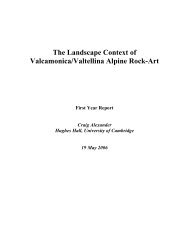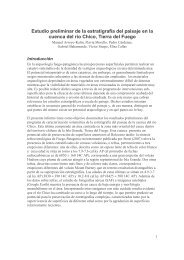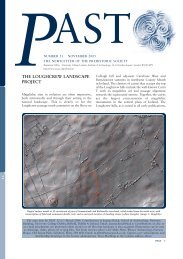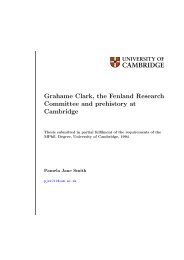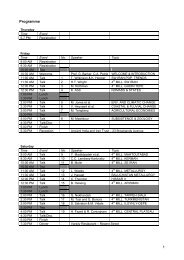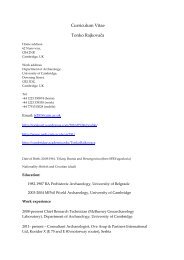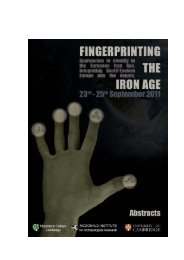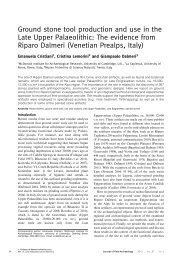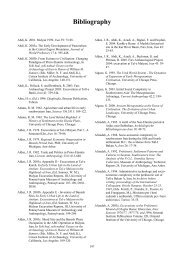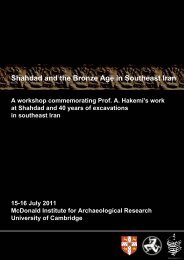Bova Marina Archaeological Project - Department of Archaeology
Bova Marina Archaeological Project - Department of Archaeology
Bova Marina Archaeological Project - Department of Archaeology
You also want an ePaper? Increase the reach of your titles
YUMPU automatically turns print PDFs into web optimized ePapers that Google loves.
each site to the different environmental zones<br />
defined earlier.<br />
Combining yield and accessibility values,<br />
three kinds <strong>of</strong> dynamic simulations were run on a<br />
fixed population-size (50 people) for purposes <strong>of</strong><br />
simplicity. Each simulation can be considered as a<br />
sequence <strong>of</strong> events. The first simulation shows how<br />
far people need to travel before reaching enough<br />
land for their particular economies. The assessment<br />
<strong>of</strong> the size <strong>of</strong> land needed per population and<br />
economy was based on literature, especially the<br />
work <strong>of</strong> Susan Gregg (Gregg 1988). The value <strong>of</strong><br />
specific land use and its land size desired will<br />
depend on the economy used. Farmland will be<br />
more important in the horticulturalist and mixed<br />
farming-foraging economies than in the pastoralist<br />
and forager ones. For foraging a larger territory is<br />
required, although it does not have the same impact<br />
on the land. For herding, a slightly larger terrain<br />
will also be necessary as animal husbandry is more<br />
mobile than farming. This will have an effect on<br />
the time and distance needed to cover to achieve<br />
the suitable land size for the amount <strong>of</strong> people<br />
concerned.<br />
A second kind <strong>of</strong> simulation is<br />
vegetational growth. One starts from a set <strong>of</strong> empty<br />
maps, which all grow a particular kind <strong>of</strong><br />
vegetation during a fixed time period. After the<br />
vegetation has iterated for a particular amount <strong>of</strong><br />
time, the simulation stops and assumptions can be<br />
made about when a vegetation type reaches its<br />
climax state as each type grows at its own rate. It<br />
was assumed that wet plants will grow faster than<br />
plants on heavy soil, depending on the soil texture,<br />
temperature and precipitation. Beach vegetation is<br />
conditioned to withstand a lot <strong>of</strong> extreme climatic<br />
and edaphic conditions and will grow at an average<br />
rate. Varied plants were given a rate <strong>of</strong> growth in<br />
between the other types <strong>of</strong> vegetation.<br />
For the purpose <strong>of</strong> simplicity, both<br />
previous simulations were combined. First, the<br />
natural vegetation grows for a fixed amount <strong>of</strong><br />
years until it is mature enough to let people use it<br />
for their specific purposes. Humans then use the<br />
land for farming, herding or foraging for a certain<br />
period, after which these are abandoned and the<br />
natural vegetation can grow back slowly. Because<br />
<strong>of</strong> the different impacts that foraging, farming and<br />
herding can have on the environment, different<br />
parameters were used in the regeneration <strong>of</strong> the<br />
vegetation. This is because land that has been used<br />
for herding and agriculture is a lot more degraded<br />
than when it was used for foraging and it will take<br />
longer for natural vegetation to grow back. Huntergatherers<br />
tend not to exhaust their environments in<br />
order to reserve the possibility <strong>of</strong> returning to them<br />
after several seasons. The result is a total <strong>of</strong> 36<br />
22<br />
<strong>Bova</strong> <strong>Marina</strong> <strong>Archaeological</strong> <strong>Project</strong> 1999<br />
maps, defining land use per site, economy and<br />
specific type <strong>of</strong> impact on the environment. Some<br />
examples are displayed as Figure 5.<br />
When simulating these land use maps,<br />
some basic assumptions were used, which applied<br />
to the yield and accessibility. For people to use a<br />
particular landscape zone, the yield has to be<br />
sufficiently high in order to be selected. In<br />
addition, it is assumed that foraging people will<br />
travel further than those herding and farming.<br />
Therefore the cost assumptions are different per<br />
specific land use. This will influence the land use<br />
maps and is interesting in comparative studies. It<br />
was also moderately based upon literature about<br />
site catchment analysis (Higgs and Vita-Finzi 1972:<br />
27-36; Jarman, Bailey and Jarman 1982: 26-46).<br />
The analysis thus resulted in maps<br />
illustrating anthropogenic environmental impact<br />
and potential spatial dimensions <strong>of</strong> the cultural<br />
world that humans lived in. These results have two<br />
basic implications. One is economic and ecological:<br />
human landscape use and environmental impact can<br />
be examined in a systematic way, in contrast to<br />
isolated single site-based studies. The second is<br />
cultural: humans use the landscape, including ‘<strong>of</strong>fsite’<br />
areas for many other non-economic uses.<br />
Many <strong>of</strong> these uses are conditioned by the existent<br />
human use <strong>of</strong> those areas.<br />
In this regard, it is interesting to observe<br />
that sites are preferably ecotonally located,<br />
enabling the exploitation <strong>of</strong> two or even three<br />
resource zones: cultivation on a plateau, some<br />
pasture for grazing and a possibility for hunting and<br />
gathering in wooded alluvial margins.<br />
The primary result <strong>of</strong> the GIS study to date<br />
is to underline the importance <strong>of</strong> non-farming land<br />
uses for site distribution. Instead <strong>of</strong> the commonly<br />
held view that competition for farmland was <strong>of</strong><br />
greatest importance in farming societies, the<br />
simulation showed that even in these, human<br />
interaction was probably structured by non-farming<br />
uses such as the needs <strong>of</strong> foraging and pasture. The<br />
sizes <strong>of</strong> the different specific land uses such as for<br />
foraging, mixed foraging-farming, farming and<br />
herding show a different picture. In the region<br />
under consideration, farmland is stretched out in<br />
small patches around the sites, while foraging and<br />
herding zones are continuous and large. Neolithic<br />
groups were probably more mobile, using bigger<br />
territories and moving frequently within them, than<br />
is usually assumed (e.g. (Higgs and Vita-Finzi<br />
1972). This means that the distribution <strong>of</strong> sites,<br />
even in mountainous areas like Calabria, should<br />
not be limited to available farmland. Observing the<br />
contacts between the areas <strong>of</strong> human impact<br />
associated with different sites enables inference <strong>of</strong><br />
possible elements <strong>of</strong> South Italian social and


